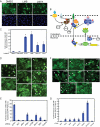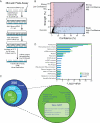Whole genome siRNA cell-based screen links mitochondria to Akt signaling network through uncoupling of electron transport chain
- PMID: 21460183
- PMCID: PMC3093329
- DOI: 10.1091/mbc.E10-10-0854
Whole genome siRNA cell-based screen links mitochondria to Akt signaling network through uncoupling of electron transport chain
Abstract
Forkhead transcription factors (FOXOs) alter a diverse array of cellular processes including the cell cycle, oxidative stress resistance, and aging. Insulin/Akt activation directs phosphorylation and cytoplasmic sequestration of FOXO away from its target genes and serves as an endpoint of a complex signaling network. Using a human genome small interfering RNA (siRNA) library in a cell-based assay, we identified an extensive network of proteins involved in nuclear export, focal adhesion, and mitochondrial respiration not previously implicated in FOXO localization. Furthermore, a detailed examination of mitochondrial factors revealed that loss of uncoupling protein 5 (UCP5) modifies the energy balance and increases free radicals through up-regulation of uncoupling protein 3 (UCP3). The increased superoxide content induces c-Jun N-terminal kinase 1 (JNK1) kinase activity, which in turn affects FOXO localization through a compensatory dephosphorylation of Akt. The resulting nuclear FOXO increases expression of target genes, including mitochondrial superoxide dismutase. By connecting free radical defense and mitochondrial uncoupling to Akt/FOXO signaling, these results have implications in obesity and type 2 diabetes development and the potential for therapeutic intervention.
Figures






Similar articles
-
Protein tyrosine phosphatase 1B inhibition ameliorates palmitate-induced mitochondrial dysfunction and apoptosis in skeletal muscle cells.Free Radic Biol Med. 2013 Dec;65:1435-1446. doi: 10.1016/j.freeradbiomed.2013.09.019. Epub 2013 Oct 10. Free Radic Biol Med. 2013. PMID: 24120971
-
Mitochondrial UCP4 attenuates MPP+ - and dopamine-induced oxidative stress, mitochondrial depolarization, and ATP deficiency in neurons and is interlinked with UCP2 expression.Free Radic Biol Med. 2009 Mar 15;46(6):810-20. doi: 10.1016/j.freeradbiomed.2008.12.015. Epub 2008 Dec 25. Free Radic Biol Med. 2009. PMID: 19150400
-
FoxO proteins' nuclear retention and BH3-only protein Bim induction evoke mitochondrial dysfunction-mediated apoptosis in berberine-treated HepG2 cells.Free Radic Biol Med. 2014 Nov;76:185-99. doi: 10.1016/j.freeradbiomed.2014.07.039. Epub 2014 Aug 13. Free Radic Biol Med. 2014. PMID: 25128467
-
Redox regulation of FoxO transcription factors.Redox Biol. 2015 Dec;6:51-72. doi: 10.1016/j.redox.2015.06.019. Epub 2015 Jul 3. Redox Biol. 2015. PMID: 26184557 Free PMC article. Review.
-
Physiological functions of the mitochondrial uncoupling proteins UCP2 and UCP3.Cell Metab. 2005 Aug;2(2):85-93. doi: 10.1016/j.cmet.2005.06.002. Cell Metab. 2005. PMID: 16098826 Review.
Cited by
-
Transcriptomic analysis unveils correlations between regulative apoptotic caspases and genes of cholesterol homeostasis in human brain.PLoS One. 2014 Oct 16;9(10):e110610. doi: 10.1371/journal.pone.0110610. eCollection 2014. PLoS One. 2014. PMID: 25330190 Free PMC article.
-
Oxidative stress and inflammation interactions in human obesity.J Physiol Biochem. 2012 Dec;68(4):701-11. doi: 10.1007/s13105-012-0154-2. Epub 2012 Feb 17. J Physiol Biochem. 2012. PMID: 22351038 Review.
-
CRM1 inhibition induces tumor cell cytotoxicity and impairs osteoclastogenesis in multiple myeloma: molecular mechanisms and therapeutic implications.Leukemia. 2014 Jan;28(1):155-65. doi: 10.1038/leu.2013.115. Epub 2013 Apr 16. Leukemia. 2014. PMID: 23588715 Free PMC article.
-
Mitochondrial uncoupling links lipid catabolism to Akt inhibition and resistance to tumorigenesis.Nat Commun. 2015 Aug 27;6:8137. doi: 10.1038/ncomms9137. Nat Commun. 2015. PMID: 26310111 Free PMC article.
-
Identification of Meflin as a Potential Marker for Mesenchymal Stromal Cells.Sci Rep. 2016 Feb 29;6:22288. doi: 10.1038/srep22288. Sci Rep. 2016. PMID: 26924503 Free PMC article.
References
-
- Amat R, Solanes G, Giralt M, Villarroya F. SIRT1 is involved in glucocorticoid-mediated control of uncoupling protein-3 gene transcription. J Biol Chem. 2007;282:34066–34076. - PubMed
-
- Barthel A, Schmoll D, Unterman TG. FoxO proteins in insulin action and metabolism. Trends Endocrinol Metab. 2005;16:183–189. - PubMed
Publication types
MeSH terms
Substances
Grants and funding
LinkOut - more resources
Full Text Sources
Research Materials
Miscellaneous

